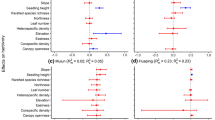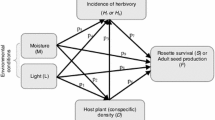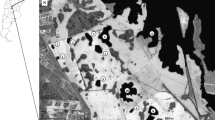Abstract
We assessed density- and distance-dependence in herbivore effects and juvenile condition for four species of Shorea, the most speciose genus in the dominant canopy family of southeast Asian rain forest trees (Dipterocarpaceae). Herbivore damage was quantified as partial leaf loss on young leaves, and whole plant foliar condition as the product of the fraction of leaf nodes containing leaves and the fraction of tissue remaining on extant leaves. Adults of the four species were centers of high total, as well as conspecific, density of juveniles (<1 m tall). For two species, S. hopeifolia and S. pinanga, herbivore damage declined significantly with distance, decreasing by 40% and 51% respectively, between 5 m and 35 m from the parent. For the same two species, foliar condition improved significantly between 5 m and 35 m, increasing by 45% for S. hopeifolia and 24% for S. pinanga. If foliar condition influences juvenile survival and growth, more widely dispersed seeds of these species are more likely to recruit to the canopy. In contrast, there was no significant distance-dependence for S. parvifolia or S. longisperma. Among species, herbivore damage was greatest in those species with greatest local juvenile abundances, i.e., those with highest densities, leaf size, juvenile foliar mass and/ or foliar mass/m2 ground area, but was unrelated to the toughness of mature leaves. However, distance was a better predictor of herbivore damage than was conspecific juvenile density, as evaluated by backward elimination regressions, for both S. hopeifolia and S. pinanga. For foliar condition, the best predictor was distance for S. pinanga, but conspecific density for S. hopeifolia, whose juveniles were smallest and occurred at the highest densities. Total juvenile density (all woody plants) was eliminated as a factor in all cases. The species-specificity of effects (i.e., their dependence on conspecific distance or density), together with the marked differences among congeneric species, caution against generalizations regarding distance-dependent effects in diverse forests.
Similar content being viewed by others
Author information
Authors and Affiliations
Additional information
Received: 21 April 1998 / Accepted: 8 July 1998
Rights and permissions
About this article
Cite this article
Blundell, A., Peart, D. Distance-dependence in herbivory and foliar condition for juvenile Shorea trees in Bornean dipterocarp rain forest. Oecologia 117, 151–160 (1998). https://doi.org/10.1007/s004420050643
Issue Date:
DOI: https://doi.org/10.1007/s004420050643




